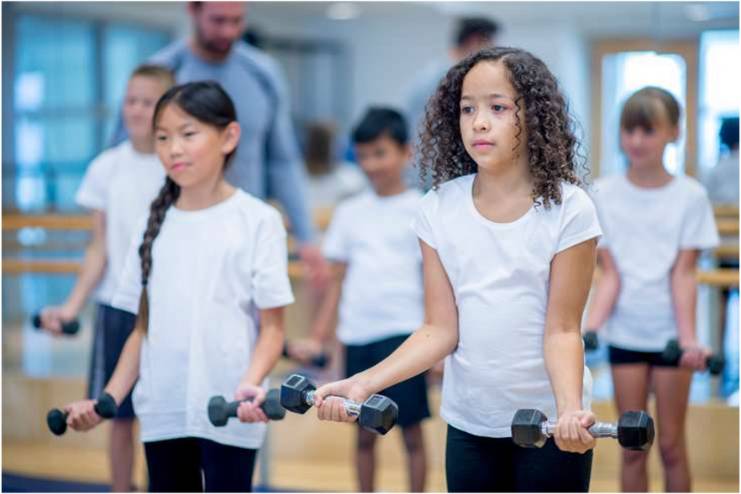Affiliate Disclaimer
Some links in this article are affiliate links. We may earn a small commission if you make a purchase through these links, at no extra cost to you. We only recommend products we find useful to our readersFrequently, children wearing weights spark heated debates. Is it safe to use? Does it prevent growth? While adults have traditionally been the only ones to use weight training, a growing body of research suggests that both young athletes and non-athletes can significantly benefit from it. Children can safely participate in strength training under the proper supervision and benefit from increased self-esteem, better coordination, and stronger muscles. However, the impact of strength training on growth plates and the risk of injury continue to raise concerns.
In actuality, weight training for children is safe and advantageous when done under expert supervision. The secret is to adjust programs to each child’s developmental stage and prioritize form over hefty loads.
Benefits of Strength Training for Children

Strength training for kids focuses on lifting weights and lays the foundation for resilience and long-term health. It offers several advantages beyond physical strength when customized for a child’s age and skill level. Here’s how:
Increased Muscle Strength and Endurance: Children who participate in strength training gain more muscular strength and endurance, making it very easier for them to carry out daily tasks. This increase in strength promotes a sense of accomplishment, whether they are lugging their school backpack or performing well in sports.
Enhancing sports coordination and preventing injuries is crucial for young athletes. Strength training enhances body mechanics, balance, and motor skills. It lowers the chance of common sports injuries like sprains and strains and improves athletic performance. Teaching children to manage their movements better prepares them to stay safe on the field.
Enhances healthy habits and self-confidence: Strength training has equally significant psychological advantages. Children’s confidence increases as they see their development, whether lifting greater weights or learning new routines. This accomplishment inspires them to set and work toward goals in various spheres of their lives.
Children who participate in strength training gain mental and physical strength, preparing them to face life’s obstacles with courage and confidence.
Safety Guidelines for Kids Lifting Weights

Safety is not merely a precaution for children lifting weights; it is the cornerstone of their strength training experience. Here’s how to minimize risks and make sure they benefit:
Speak with an expert: Choose a personal trainer or coach with experience working with young people interested in strength training. Based on your child’s age, size, abilities, and sports interests, the coach or trainer can design a safe strength training program that suits them. Or sign up your kid for a kid-friendly strength training class.
Warm-up and cool-down: Every strength training session should start with five to ten minutes of mild cardiovascular exercise for your child. It could involve strolling, stationary jogging, or rope jumping. It gets the muscles warmed up and ready for more demanding tasks.
Age-Related Exercises: For younger kids, the emphasis should be on learning how to perform bodyweight exercises like planks, squats, and push-ups. These exercises provide a strong foundation for coordination and strength without external weights. As they mature and gain self-assurance, they can add light weights or resistance bands in moderation.
Pay attention to proper form: Your child’s form and technique are more significant than their weightlifting capacity. As they gain strength, kids can gradually increase the resistance or the number of repetitions.
Take a break between workouts: Make sure your youngster has at least one full day off between working out each of the main muscle groups: the legs, hips, back, belly, chest, shoulders, and arms.
Children can safely experiment with weight training by adhering to these rules and developing strength and self-assurance in a setting intended to safeguard and foster their growth.
Myths about Kids Lifting Weights

A common misconception about children and weightlifting is that it stunts growth. This outdated idea has long discouraged parents from letting their kids participate in strength training.
Myth: Weightlifting Stunts Growth
Experts believe lifting weights could potentially damage growth plates—the forming cartilage regions at the ends of long bones—thereby halting a child’s growth. Although growth plate injuries can impact development, improper technique, lifting without supervision, or trying to lift too much weight too fast are more common causes of these injuries than weightlifting itself.
According to a study that examined weightlifting in children and adults, 77% of children injured when lifting weights experienced an accident, such as dropping a weight on their foot, rather than a strained muscle or broken bone from lifting too much weight.
Fact: Proper Training Supports Musculoskeletal Development
When done properly under expert guidance, strength training improves growth, not hinders it. Studies have shown that age-appropriate weightlifting can significantly increase bone density, strengthen tendons, and improve joint health. These advantages help children’s musculoskeletal systems become more resilient, giving them a solid foundation as they mature.
Appropriate Strength Training Programs for Children
For children, strength training does not include going to the gym like an experienced bodybuilder. Instead, it’s about designing a well-rounded, entertaining routine that safely and successfully builds their strength. Here’s how to create the perfect program:
Include age-appropriate exercises: To begin, perform bodyweight exercises that help develop core strength and stability, such as planks, squats, and push-ups. Introduce resistance bands to children as they get more self-assured and capable; they offer a flexible and safe approach to increase difficulty without putting them under undue stress. Add light dumbbells for older kids, focusing on exercises like the shoulder presses and bicep curls that enhance everyday functional strength.
Stress frequency and rest: Experts recommend that children engage in strength training two to three times a week, allowing sufficient recovery between sessions for optimal outcomes. This frequency balances regular practice and rest, which are essential for building and repairing muscles. Rest days are equally important as workout days since overtraining can cause weariness and raise the risk of injury.
Keep It Fun and Dynamic: Keeping people interested and involved requires variety. By switching up the exercises and adding games or challenges, every session may be enjoyable.
When to Avoid Weight Training

Even though youngsters can benefit greatly from weight training, it’s not always the best option. Long-term health and safety depend on knowing when to stop or refrain from strength exercise.
Children with chronic illnesses or injuries should wait to lift weights until they are well. Children with injuries, especially those involving the muscles, joints, or bones, should refrain from lifting weights until they are well. Strength training has the potential to worsen pre-existing conditions and delay their resolution.
Kids with long-term illnesses such as juvenile arthritis or cardiovascular issues also require a customized strategy. Before starting or maintaining any strength training program in these situations, speaking with a healthcare provider is imperative.
Be vigilant for signs of joint pain or overexertion. Excessive effort might backfire, even in healthy children. Red flags include symptoms like exhaustion that doesn’t go away with rest, chronic joint pain, or muscular soreness beyond the normal post-workout discomfort. These symptoms may indicate overexertion or poor technique, which can lead to injuries. According to parents and trainers, children should emphasize rest when necessary and pay attention to their bodies.
Conclusion
When done carefully and under supervision, strength training can transform children’s lives. In addition to increasing muscle strength, it promotes self-assurance, coordination, and positive lifestyle choices. Professional supervision, however, is the cornerstone of safe and successful training. With an emphasis on proper form and controlled movements, certified trainers ensure that workouts are appropriate for a child’s age and skill level. Consider strength training progress as a process, not a competition.
References
- https://www.mayoclinic.org/healthy-lifestyle/tween-and-teen-health/in-depth/strength-training/art-20047758
- https://kidshealth.org/en/parents/strength-training.html
- https://publications.aap.org/pediatrics/article/145/6/e20201011/76942/Resistance-Training-for-Children-and-Adolescents
- https://www.nationwidechildrens.org/specialties/sports-medicine/sports-medicine-articles/strength-training-for-children-can-we-do-that
- https://www.stanfordchildrens.org/en/topic/default?id=weight-room-no-longer-off-limits-to-kids-1-1187
- https://www.ctpomd.com/post/guidelines-for-weightlifting-for-kids
- https://health.choc.org/is-strength-training-safe-for-kids-and-teens/
- https://pubmed.ncbi.nlm.nih.gov/19855330/
- https://www.gymaholic.co/articles/6-myths-about-teens-and-strength-training-shattered
- https://jamanetwork.com/journals/jamapediatrics/article-abstract/2795689
- https://www.verywellfit.com/a-weight-training-workout-for-children-3498516
- https://www.stack.com/a/pre-teen-strength-training-program/
- https://lifehacker.com/the-best-strength-training-routine-for-kids-and-maybe-1849120364
- https://www.strengthlog.com/strengthlogs-training-program-for-children/
- https://www.nationwidechildrens.org/specialties/sports-medicine/sports-medicine-articles/strength-training-for-children-can-we-do-that
- https://www.childrens.com/health-wellness/what-age-can-you-start-lifting-weights
- https://www.stlouischildrens.org/health-resources/pulse/should-child-athletes-lift-weights
- https://www.usatoday.com/story/sports/2023/07/15/weight-lifting-for-youth-athletes-when-should-teenagers-start/70417007007/
- https://pmc.ncbi.nlm.nih.gov/articles/PMC3445252/
- https://www.parents.com/parenting/better-parenting/teenagers/does-lifting-weights-stunt-growth-in-teens/
- https://www.healthshots.com/fitness/muscle-gain/right-age-to-start-lifting-weights/
In this Article


















